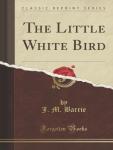The Little White Bird

The Little White Bird is a novel by J. M. Barrie, published in 1902, ranging in tone from fantasy and whimsy to social comedy with dark aggressive undertones. The book attained prominence and longevity due to several chapters written in a softer tone than the rest of the book, in which it introduced the character and mythology of Peter Pan. Those chapters were later published separately as Peter Pan in Kensington Gardens as a children's book. The Peter Pan story began as one chapter of a longer work and during the four years that Barrie worked on the book prior to publication, grew to an "elaborate book-within-a-book" of over one hundred pages.
The story is set in several locations; the earlier chapters are set in the town of London, contemporaneous to the time of Barrie's writing, and involving some time travel of a few years, and other fantasy elements, while remaining within the London setting. The middle chapters that later became Peter Pan in Kensington Gardens are set in London's famous Kensington Gardens, introduced by the statement that "All perambulators lead to Kensington Gardens". The Kensington Gardens chapters include detailed descriptions of the features of the Gardens, along with fantasy names given to the locations by the story's characters, especially after "Lock-Out Time", described by Barrie as the time at the end of the day when the park gates are closed to the public, and the fairies and other magical inhabitants of the park can move about more freely than during the daylight, when they must hide from ordinary people. The third section of the book, following the Kensington Gardens chapters, are again set generally in London, though there are some short returns to the Gardens that are not part of the Peter Pan stories. In a two-page diversion in chapter 24, Barrie brings the story to Patagonia, and a journey by ship returning to England at the "white cliffs of Albion".
The main theme of the book is an exploration of the intimate emotional relationship of the narrator, a childless Victorian era retired soldier and London bachelor, with a young boy born to a working-class married couple in the same neighborhood. The narrator secretly assists the couple financially, while meeting with the young boy in various "adventures", presented in a disjointed series of episodes in the book in which the narrator seeks to find a feeling of closeness with the boy, expressed as a desire for fatherhood, as well as other less clearly defined ideas. Peter Hollindale, professor of English and Education Studies at the University of York (retired, 1999), has written extensively about James Barrie and the Peter Pan stories. He states that while modern psychology enables readers to find hints of various abnormalities in the story, it also remains "strangely innocent and asexual".